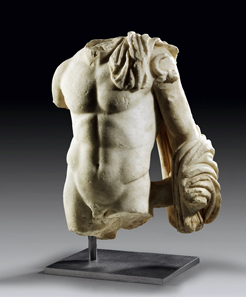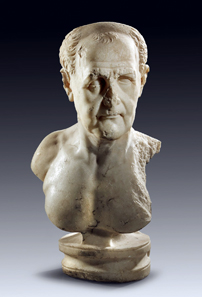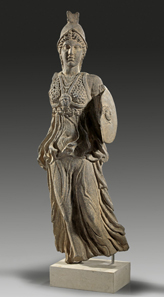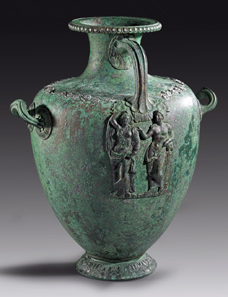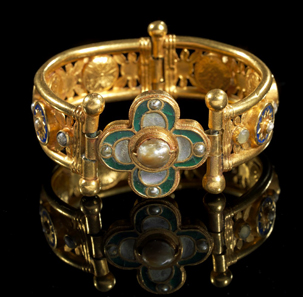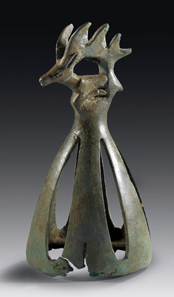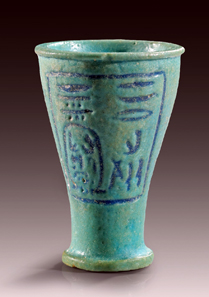17-12-2013 – 01-01-1970
Auction sale 218: Ancient Art
Precious Objects from Antiquity at Gorny & Mosch
Almost three times its estimate – that was the price the gorgeous torso of Hermes realized, called out as the very first object of the entire sale. The not quite life-size sculpture from the 1st/2nd cent. A. D. follows a Greek original of late Classical times known as ‘Hermes Richelieu’.
1: Torso of Hermes. White, finely crystalline marble. H 45 cm. Roman Imperial times, 1st-2nd cent. A. D. Estimate: 40,000 euros. End result: 120,000 euros.
A customer was willing to pay almost 120,000 euros* for that magnificent work of art (estimate: 40,000 euros).
5: Portrait bust of an aged Roman. Trajanic, 1st quarter of 1st cent. A. D. White, finely crystalline marble. H. 59 cm. Estimate: 90,000 euros. End result: 150,000 euros.
Considerably higher was the prize the new owner of the portrait bust of an elderly Roman had to pay. The wonderful veristic old age portrait of a man from Trajanic times harks back to late Republican portraits such as the ones we know from many coins. The artist didn’t pay any attention to vanity when he sculpted the commissioner’s mouth shrunken due to the loss of teeth against the backdrop of Roman politicians being appreciated not so much for a juvenile appearance but for their dignity, life experience and solemnity. The end result for this masterpiece was more than 150,000 euros on a pre-sale estimate of 90,000 euros.
9: Athena made of black basalt. 2nd/3rd cent. A. D. H. 73 cm. Estimate: 20,000 euros. End result: 70,000 euros.
Three and a half times its estimate was realized by a statuette of Athena made of black basalt with pseudo-Corinthian helmet. The interesting object dates to the 2nd/3rd century A. D. and changed hands for 70,000 euros (estimate: 20,000 euros).
Almost 24,000 euros were yielded by a weight, estimated at 4,000 euros only, which depicts a walking elephant to the left on its obverse. In addition, a countermark in the shape of an anchor was stamped on it, as a sign of its official legitimation. With its prize of 26,000 euros likewise noteworthy is the result of the Roman military diploma of a praetorian dating to A. D. 119 whose interior is well readable (estimate: 15,000 euros).
36: Bronze hydria. Greek, 4th cent. B. C. H 47.5 cm. Estimate: 175,000 euros. End result: 413,000 Euros.
The most expensive item of the auction sale was a magnificent bronze hydria, lavishly decorated with silver inlays and a wonderful figural attachment. It depicts a couple, united in tender affection. That magnificent object had been estimated at 175,000 euros. The result achieved was nothing less than 413,000 euros!
72: Pair of gold bracelets with lapis lazuli, beads and glass. Eastern Mediterranean region, early Byzantine, 5th-7th cent. A. D. 69.79 g and 67.05 g; Dm 6.3 and 6.5 cm. Estimate: 100,000 euros. End result: 177,000 euros.
Let us single out another result from the six-figure region. A pair of elaborate Cloisonné gold bracelets from early Byzantine times that are highly likely to have been produced in a workshop that worked on behalf of the imperial court had been estimated at 100,000 euros. An aficionado paid 177,000 euros for these fine bracelets which hopefully will not end up in some showcase but are allowed instead to serve their original purpose.
Of course, not only the highlights of the sale were good sellers. The four-figure region came up with notable price rises, too. To name but a few examples: a Mycenaean Psi idol whose upper body is decorated with painted wavy lines (340; estimate: 1,000 euros; end result: 4,700 euros), a Hellenistic silver cup from the 3rd/2nd cent. B. C. (465; estimate: 1,500 euros; end result: 3,500 euros), a bronze hydria dating to the late 5th century B. C. (476; estimate: 3,000 euros; end result: 16,500 euros), a tile with the seal of Nebuchadnezzar II (583; estimate: 3,500 euros; end result: 6,500 euros), …
611: Bronze chariot attachment. Scythian, 6th cent. B. C. H. 20.5 cm. Estimate: 1,500 euros. End result: 7,700 euros.
… a Scythian chariot attachment from the 6th century B. C. (611; estimate: 1,500 euros; end result: 7,700 euros), and a Byzantine bronze pendant with enamel decoration and an inscription (632; estimate: 800 euros; end result: 5,900 euros).
Last but not least, the special collection Egypt: Almost 70 lots were available for sale. Of particular interest was the wooden statuette of a girl walking, dating to the 18th/19th dynasty of the New Kingdom (c. 1380-1293 B. C.). The roughly 24.5 cm high object rose to 6,500 euros in the end, on a pre-sale estimate of 2,000 euros. Even higher, on a percentage basis, was the rise of the wood depiction of a rower dating to the Middle Kingdom (c. 2137-1781). It was introduced with an estimate of 700 euros, to finally change hands for 3,500 euros.
579: Votive vessel with cartouche of King Nectanebo II. 4th cent. B. C. H 5.2 cm. Estimate: 1,600 euros. End result: 4,250 euros.
An intact votive vessel of King Nectanebo II, the final ‘native’ king of Egypt who was defeated by the Persians in 341, concludes this review. The lot had been estimated at 1,600 euros and realized 4,250 euros.
Although this review might indicate that one had to be a person of considerable means in order to buy ancient art, the 110 interestingly assembled multiple lots – of which some realized sums higher than their estimate – proved that assumption wrong. Anyone who had taken his time to examine the items was able to make an inexpensive purchase.
All results can be viewed on the internet. The next auction sale on ‘Ancient Art’ is scheduled for June 2014. Consignments are welcome until March 2014. Get further information at Gorny & Mosch, Giessener Münzhandlung, Maximiliansplatz 20, D-80333 Munich, phone +49 / (0)89 / 24 22 643-0, fax +49 / (0)89 / 22 85 513.
* All prices include 18 % buyer’s premium and are slightly rounded.





